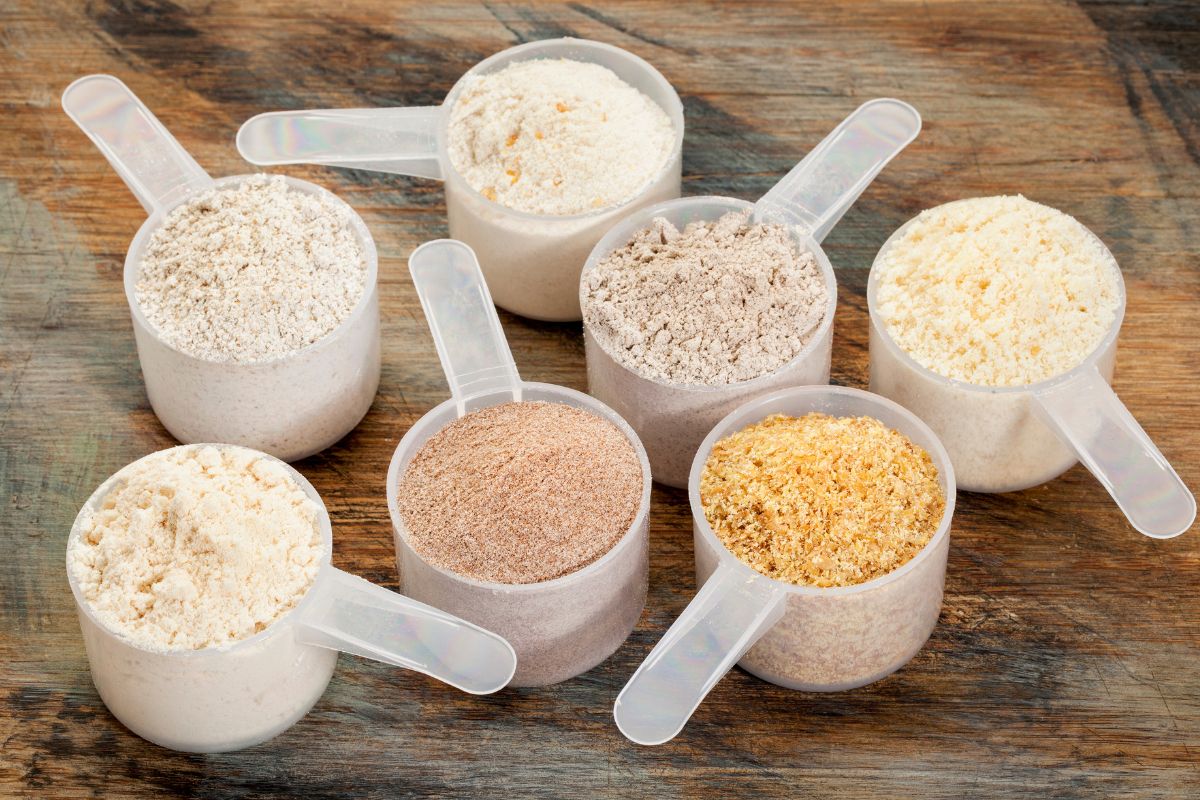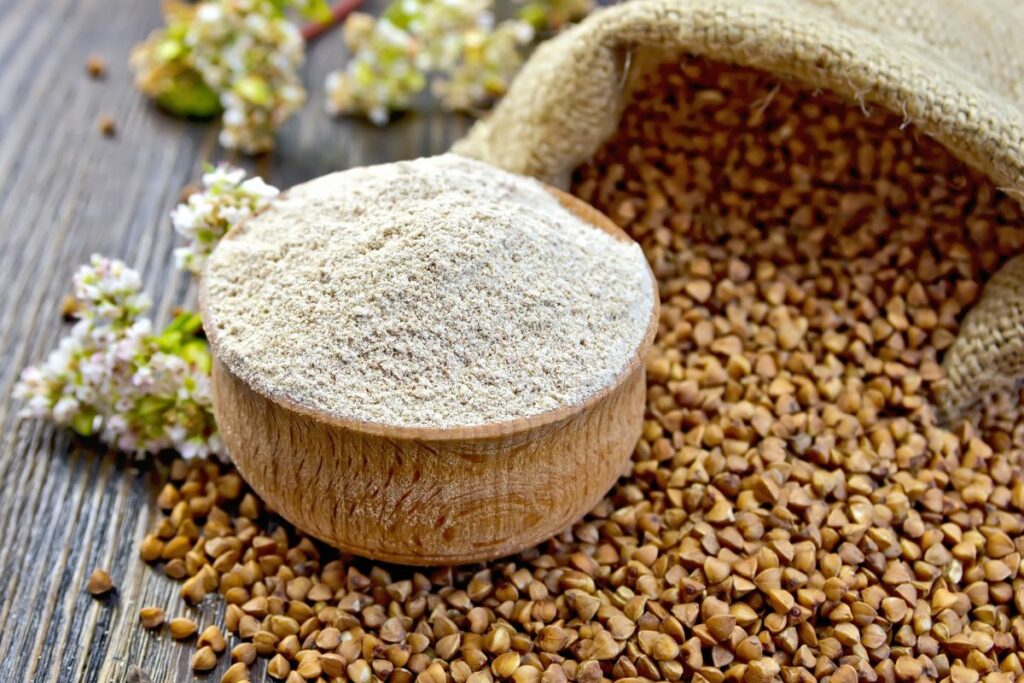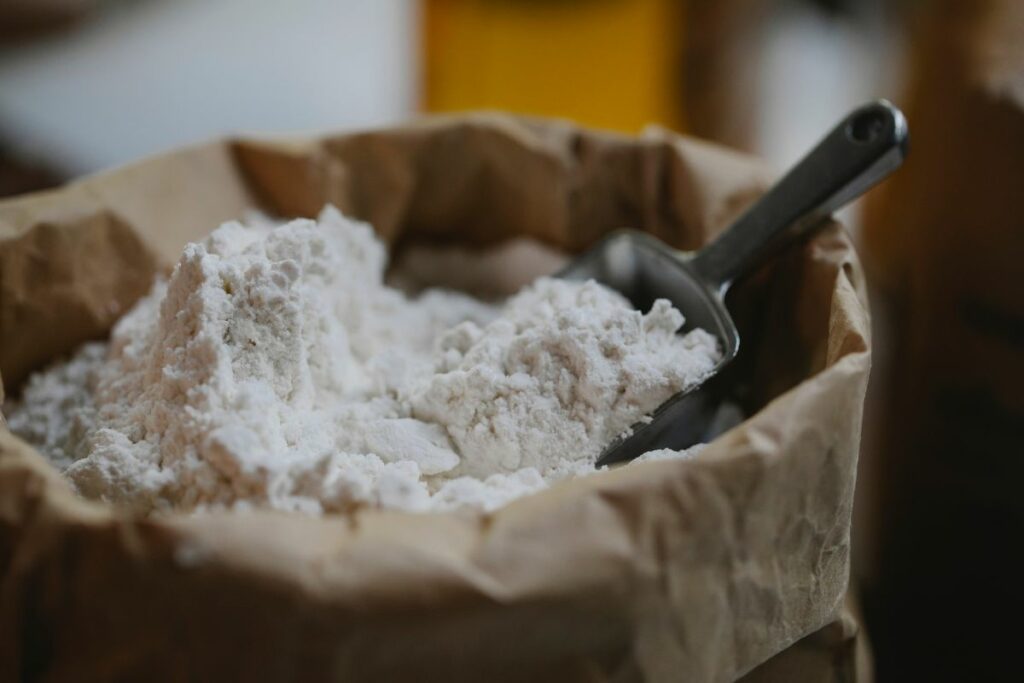People with gluten intolerance or celiac disease often have to avoid wheat-based foods, including buckwheat flour. Buckwheat flour is a gluten-free alternative that is rich in nutrients and minerals, making it a popular choice in gluten-free baking. However, if you cannot find buckwheat flour or want to try new flavors, there are many other gluten-free flour that can be used as a substitute.
One of the most commonly used substitutes for buckwheat flour is wheat flour. While wheat flour is not gluten-free, it can be used as a soft option for those who are not allergic to gluten. Other gluten-free flour that can be used as a substitute for buckwheat flour include oat flour, which is a protein-rich alternative that tastes sweet and nutty like buckwheat flour. Sorghum flour is another gluten-free substitute that works well in baked goods and has a slightly nutty and sweet flavor similar to buckwheat. Teff flour is a type of flour made from ground teff grains, which is high in protein, fiber, and minerals such as iron, magnesium, and zinc.
There are many other gluten-free flours that can be used as a substitute for buckwheat flour, each with its own unique flavor and texture. In this article, we will explore the best substitutes for buckwheat flour and how to use them in gluten-free baking. Whether you have a gluten intolerance or simply want to try new flavors, these substitutes can help you create delicious and healthy baked goods without compromising on taste or quality.

Contents
Understanding Gluten-Free Flours
Gluten-free flours are becoming increasingly popular as more and more people are discovering that they have gluten sensitivities or celiac disease. Gluten is a protein found in wheat, rye, and barley, and it can cause digestive issues for those who are sensitive to it.
When it comes to gluten-free flours, there are many options available, each with its own unique properties. Some of the most popular gluten-free flour include almond flour, coconut flour, rice flour, and buckwheat flour.
Buckwheat flour is a great option for those who are looking for a gluten-free substitute for wheat flour. It is made from the seeds of the buckwheat plant and has a slightly nutty flavor. Buckwheat flour is also high in protein and fiber, making it a healthy choice for those who are looking to maintain a balanced diet.
It is important to note that not all gluten-free flour can be used as a direct substitute for wheat flour. Gluten-free flours have different properties and may require different ratios or additional ingredients to achieve the same results as wheat flour. For example, almond flour is high in fat and can make baked goods more dense, so it may need to be combined with other flours to achieve the desired texture.
In addition to being a great option for those with gluten sensitivities, gluten-free flours can also be a healthy choice for anyone looking to incorporate more whole grains into their diet. Many gluten-free flours are made from nutrient-dense ingredients like nuts, seeds, and whole grains, which can provide a variety of health benefits.
Overall, understanding the properties and uses of different gluten-free flours can help you make informed choices about which flours to use in your cooking and baking.
Why Buckwheat Flour
Buckwheat flour is a popular gluten-free flour substitute that is used in a variety of baked goods. This flour has a distinct nutty and earthy flavor that adds depth to recipes. Buckwheat flour is not only gluten-free but also rich in nutrients, making it a healthy addition to any diet.
Buckwheat flour is made from the seeds of the buckwheat plant, which is not related to wheat. This makes buckwheat flour a great alternative for people with gluten allergies or sensitivities. Buckwheat flour is commonly used in Japanese soba noodles and buckwheat pancakes, which are both delicious and nutritious.
One of the key nutrients found in buckwheat flour is magnesium. Magnesium is an essential mineral that plays a vital role in many bodily functions, including nerve and muscle function, blood sugar regulation, and bone health. Buckwheat flour is also rich in antioxidants, which help protect the body from damage caused by free radicals.
In addition to its nutritional benefits, buckwheat flour is also versatile and easy to use. It can be used in a variety of recipes, including bread, muffins, and cookies. Buckwheat flour can be mixed with other gluten-free flours like brown rice flour and almond flour to create a flour blend that mimics the taste and texture of wheat flour.
Overall, buckwheat flour is a great gluten-free substitute that offers a unique flavor and a wide range of health benefits. Whether you’re looking to make gluten-free baked goods or simply want to add a nutrient-rich flour to your diet, buckwheat flour is a great choice.

Gluten-Free Substitutes for Buckwheat Flour
For those who are gluten intolerant or following a gluten-free diet, finding a substitute for buckwheat flour can be a challenge. However, there are several options available that can be used as an effective replacement for buckwheat flour in recipes.
Rice Flour
Rice flour is a versatile gluten-free substitute for buckwheat flour. It is made by grinding rice into a fine powder and has a mild, slightly sweet flavor. Rice flour can be used in a variety of recipes, including bread, cakes, and noodles.
Chickpea Flour
Chickpea flour is another gluten-free substitute that can be used in place of buckwheat flour. It has a slightly nutty flavor and is high in protein, making it a great choice for those looking to add more protein to their diet. Chickpea flour can be used in recipes for bread, pancakes, and crackers.
Oat Flour
Oat flour is a gluten-free flour that is made by grinding rolled oats into a fine powder. It has a slightly sweet, nutty flavor and can be used in a variety of recipes, including bread, pancakes, and cookies.
Tapioca Flour
Tapioca flour is a gluten-free flour made from the cassava plant. It has a neutral flavor and is often used as a thickener in recipes. Tapioca flour can be used in recipes for bread, cakes, and cookies.
Sorghum Flour
Sorghum flour is a gluten-free flour that is made from the sorghum plant. It has a slightly sweet, nutty flavor and can be used in a variety of recipes, including bread, pancakes, and cakes.
Almond Flour
Almond flour is a gluten-free flour that is made from ground almonds. It has a slightly sweet, nutty flavor and is high in protein and healthy fats. Almond flour can be used in recipes for bread, cakes, and cookies.

Coconut Flour
Coconut flour is a gluten-free flour that is made from ground coconut meat. It has a slightly sweet, nutty flavor and is high in fiber and healthy fats. Coconut flour can be used in recipes for bread, cakes, and cookies.
All-Purpose Flour Alternatives
For those who prefer an all-purpose flour alternative, there are several options available, including potato starch, garbanzo bean flour, tapioca starch, quinoa flour, millet flour, potato flour, amaranth flour, spelt flour, teff flour, cassava flour, kamut flour, barley flour, corn flour, and whole wheat flour. These flours can be used in a variety of recipes, including bread, cakes, and cookies.
Overall, there are many gluten-free substitutes for buckwheat flour that can be used in a variety of recipes. Experimenting with different flours can be a fun and delicious way to explore new flavors and textures in your cooking.
Creating Gluten-Free Flour Blends
When it comes to gluten-free baking, creating the right flour blend is crucial to achieving the perfect texture and structure in your baked goods. Gluten-free flour blends are typically made up of a combination of flours, starches, and binding agents that work together to mimic the properties of wheat flour.
One common binding agent used in gluten-free flour blends is xanthan gum. Xanthan gum is a natural thickener and can help add structure and volume to gluten-free baked goods. However, some people may be sensitive to xanthan gum or simply prefer not to use it in their baking.
If you’re looking for a xanthan gum-free option, arrowroot powder can be a great substitute. Arrowroot powder is a natural thickening agent that can help add structure and elasticity to gluten-free baked goods. It’s also a great option for those who are looking for a binder that won’t add any additional flavor to their baked goods.
When creating your own gluten-free flour blend, it’s important to consider the different properties of the flours and starches you’re using. For example, rice flour is a great option for adding volume to your blend, while potato starch can help add structure and stretchiness.
Here is a simple gluten-free flour blend recipe to get you started:
- 1 cup rice flour
- 1 cup potato starch
- 1 cup arrowroot powder
Simply mix together the three ingredients until well combined and use in place of all-purpose flour in a 1:1 ratio. This blend can be used in a variety of baked goods, from cakes and cookies to bread and pizza crusts.
Overall, creating your own gluten-free flour blend can take some trial and error, but with the right combination of flours and binding agents, you can achieve delicious and successful gluten-free baked goods.

Gluten-Free Baking Tips
Baking gluten-free can be a bit of a challenge, especially when it comes to bread and cakes. However, with a few tips and tricks, it is possible to achieve delicious results.
Leavening Agents
When adapting a recipe to make it gluten-free, it is important to increase the amount of baking powder and baking soda by 25%. This is because gluten-free flours are denser than wheat flour, and they need more leavening agents to help them rise. For example, if a recipe calls for one teaspoon of baking powder, use 1 1/4 teaspoons instead. It is also important to make sure that the baking powder and baking soda are fresh and not expired.
Smaller is Better
When making gluten-free baked goods, it is best to make them smaller than you would with wheat flour. This is because gluten-free flours are denser, and they do not rise as much as wheat flour. For example, instead of making a large cake, make cupcakes or muffins. Instead of making large pancakes or waffles, make smaller ones.
Use Gluten-Free Flour Blends
There are many gluten-free flour blends available on the market that can be used as a substitute for wheat flour. These blends are usually a combination of different gluten-free flours, starches, and leavening agents. They are designed to mimic the texture and flavor of wheat flour and can be used in a variety of recipes, including bread, cakes, cookies, and biscuits.
Use Xanthan Gum or Guar Gum
Xanthan gum and guar gum are both binding agents that can be used in gluten-free baking. They help to hold the ingredients together and give the baked goods a better texture. Xanthan gum is made from fermented corn sugar, while guar gum is made from the seeds of the guar plant. Both can be found in most health food stores and can be used in a variety of recipes, including yeast bread.
Use a Food Processor or Blender
When making gluten-free baked goods, it is important to mix the ingredients well to ensure that they are evenly distributed. A food processor or blender can be used to mix the ingredients together quickly and efficiently. This is especially useful when making gluten-free flour blends or when grinding nuts or seeds into flour.
By following these tips, it is possible to achieve delicious gluten-free baked goods that are just as good as their wheat flour counterparts.

Taste and Texture of Gluten-Free Flours
When it comes to gluten-free flours, there are several options available in the market. Each flour has its unique taste and texture, making it suitable for different recipes.
One of the most popular gluten-free flours is almond flour. It has a sweet, nutty flavor that works well in baked goods such as cookies and cakes. Almond flour also has a lighter texture than wheat flour, making it perfect for creating airy and fluffy desserts.
Coconut flour, on the other hand, has a mild flavor and a slightly sweet taste. It is also highly absorbent, which means that it requires more liquid than other flours. Coconut flour is best suited for recipes that require a denser texture, such as muffins and bread.
Chickpea flour has a nutty flavor and is a great gluten-free substitute for buckwheat flour. It has a high protein content and is perfect for savory dishes like falafel and socca. Chickpea flour can also be used in sweet recipes like pancakes and cookies, but it may require a binding agent to hold the dough together.
Another gluten-free flour is rice flour, which has a mild flavor and a fine texture. It is best used in recipes that require a crispy texture, such as tempura or fried chicken. Rice flour is also a great alternative for making gluten-free pasta.
Overall, each gluten-free flour has its unique taste and texture, making it suitable for different recipes. Experimenting with different flours can help you discover new flavors and textures in your cooking.
Nutritional Benefits of Gluten-Free Flours
Gluten-free flours are a great alternative for those who suffer from celiac disease or gluten intolerance. These flours are made from grains, nuts, and seeds that do not contain gluten, a protein found in wheat, barley, and rye. One such gluten-free flour is buckwheat flour, which is a great source of protein, fiber, and healthy nutrients.
Buckwheat flour is a whole grain flour that is high in protein and fiber. It contains all nine essential amino acids, making it a complete protein source. Buckwheat flour is also rich in iron, which is essential for healthy blood cells. This flour is also a good source of magnesium, which is important for healthy bones and muscles.
Other gluten-free flours that are rich in protein and fiber include almond flour, coconut flour, and chickpea flour. Almond flour is a great source of healthy fats, while coconut flour is high in fiber. Chickpea flour is also a good source of protein and fiber and is a staple in many Indian dishes.
For those following a paleo diet, almond flour and coconut flour are great substitutes for wheat flour. These flours are also low in carbohydrates and are a good source of healthy fats. Black bean flour is another great alternative for those looking for a high-protein, gluten-free flour. It is rich in fiber, iron, and other essential nutrients.
In conclusion, gluten-free flours are a great alternative for those who suffer from celiac disease or gluten intolerance. They are rich in protein, fiber, and other essential nutrients that are important for a healthy diet. Buckwheat flour, almond flour, coconut flour, chickpea flour, and black bean flour are all great substitutes for wheat flour and can be used in a variety of recipes.

Finding Gluten-Free Flours and Substitutes
For those with gluten intolerance or celiac disease, finding gluten-free flours and substitutes can be a challenge. Fortunately, there are many options available in health food stores and online.
When looking for gluten-free flours, it’s important to consider the properties of the flour and how it will behave in recipes. Some popular gluten-free flours include almond flour, coconut flour, and chickpea flour, which are all nutrient-dense and have unique textures and flavors.
For those looking for a gluten-free option to buckwheat flour, there are several wheat flour alternatives available. Rice flour, corn flour, and potato flour are all versatile options that can be used in a variety of dishes. Additionally, tapioca starch and arrowroot powder can be used as binding agents and leavenings in gluten-free recipes.
When considering cost, it’s important to keep in mind that gluten-free flours and substitutes can be more expensive than traditional wheat flours. However, buying in bulk or online can often save money in the long run.
Overall, there are many gluten-free flours and substitutes available for those with gluten intolerance or celiac disease. By experimenting with different options and finding what works best in each recipe, it’s possible to create delicious and healthy dishes without gluten.
